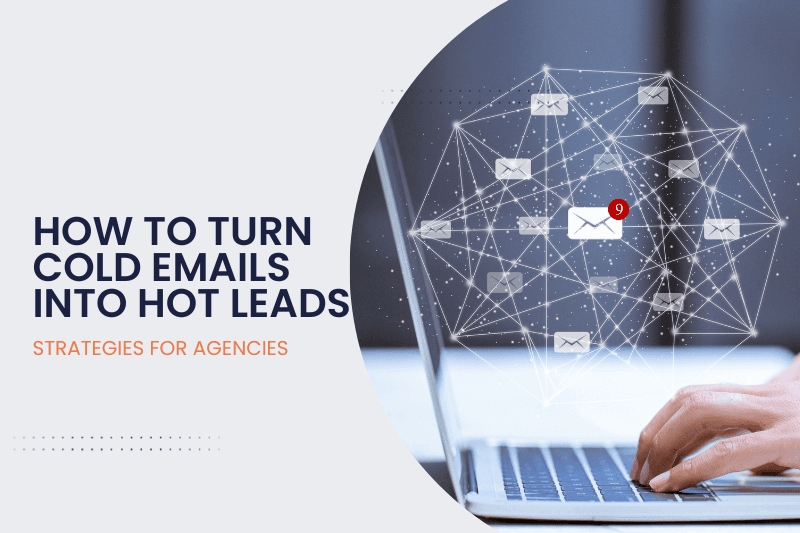Cold Email
How to Turn Cold Emails into Hot Leads: An Agency’s Guide
Turning cold emails into hot leads isn't just a magic trick for sales wizards; it's an art and a science that your agency can master.
Dec 4, 2023

You've got a list of prospects colder than a polar bear's toenails, and you're about to warm them up.
In this guide, you'll discover how to craft compelling emails, target the right prospects, and follow up effectively to ensure your cold email campaigns sizzle.
Crafting the Perfect Cold Email
When looking to book a call from a cold email, you've got to craft an email that's impossible to ignore.
Here's how you can do it, step by step.
1. Writing an Attention-Grabbing Subject Line
Your subject line is your first and often only chance to make an impression. So keep it short, intriguing, and personalized.
It should give a clear hint about the content of the email. Steer clear of generic lines like "Following Up" or "Touching Base," and instead, write something that speaks directly to your recipient's needs or pain points.
2. Personalizing Your Opening Line
Personalization is key when it comes to the opening line of your email. It's where you connect on a human level.
You might mention a recent achievement of theirs or comment on a shared interest. This shows you've done your homework, and you're not just sending out a mass email.
3. Highlighting Value Proposition
Next, you need to clearly articulate your value proposition. What can you do for your prospect?
Make sure you're addressing their specific challenges and how your agency can solve them. Use bullet points to break down complex offerings into an easy-to-understand list.
4. Including Social Proof
People trust peers more than they trust marketing. That's why including social proof, such as testimonials or case studies, can be a game-changer.
Mention a client whose business improved because of your services and link to a case study if you have one.
5. Adding a Clear Call-to-Action
Finally, your email should include a clear call-to-action (CTA). Don't leave your prospects wondering what to do next. Whether it's booking a call or responding to an email, make sure your CTA is direct and easy to follow.
Use action-oriented language and potentially provide a link to your calendar to streamline the process.
By following these steps, you'll ensure your cold emails are primed to convert leads into calls, pushing you closer to your ultimate goal of growing your agency. Remember, the key is to stay relevant, be personal, and always provide value.
Strategies for Effective Email Outreach
1. Building a Quality Email List
Your cold email campaign begins with the foundation—a quality email list. A relevant and targeted email list ensures your outreach efforts aren’t wasted on disinterested parties.
Research your audience and gather data on their needs and interests.
Focus on individuals or businesses that would benefit most from your services.
Use subscription forms on your website to attract subscribers genuinely interested in your offerings.
Verify the email addresses to maintain a high delivery rate and protect your sender's reputation.
2. Automating Outreach with Email Marketing Tools
Efficiency is crucial when you're reaching out to scores of potential leads, and that's where email marketing tools come in.
Automate sending schedules so you can focus on crafting content, not managing it.
Use CRM integrations to personalize emails based on user behavior or past interactions.
Choose tools that provide analytics to monitor open rates, click-through rates, and conversions.
Select email marketing tools with high deliverability that comply with anti-spam regulations.
3. A/B Testing and Optimizing Emails
Incremental improvements over time are the secret to successful email campaigns.
Create A/B tests for subject lines, email content, and CTAs to discover what resonates with your audience.
Track the performance data and analyze it to refine future emails.
Be ready to pivot your strategy based on what the A/B test data tells you.
4. Following Up with Persistent but Polite Reminder Emails
Never underestimate the power of a well-timed follow-up email.
Send a reminder if you haven't gotten a response within a week.
Keep your tone friendly and professional, reinforcing the value proposition.
Limit follow-ups to avoid becoming intrusive—two or three should be sufficient.
Personalize each follow-up to show continued interest and dedication to potential clients.
Tracking and Analyzing Email Performance
1. Monitoring Open Rates and Click-through Rates
When you dive into the analytics of your cold email campaign, open rates and click-through rates (CTR) are your compass in the world of email metrics.
Keep track of how many recipients are actually opening your emails—the percentage here gives you a direct insight into how effective your subject line is.
Click-through rates are even more telling, as they measure how many readers clicked on links within the email. A high CTR indicates your content is relevant and your call-to-action (CTA) is compelling.
To increase these metrics:
Use engaging subject lines that resonate with your audience
A/B test different CTAs to find the most effective one
2. Analyzing Response Rates and Conversion Rates
Beyond opens and clicks lie the response and conversion rates, which are crucial for your agency's ultimate goal: turning cold emails into hot leads.
A high response rate means your message is not just seen but also prompts action. This is where your personalized approach really pays off.
The conversion rate goes a step further—it measures how many of these interactions lead to a booked call or another desired action.
You'll want to analyze:
Which messages yield the highest response
The number of leads that move through your sales funnel
Strategies for improvement include refining your value proposition and segmenting your list to target prospects more effectively.
3. Using Email Analytics Tools to Track Performance Metrics
To accurately track these vital statistics, you'll need robust email analytics tools. These tools provide comprehensive insights and allow you to adjust your strategy in real time.
Some popular features to look for are:
Detailed reports on opens, clicks, bounces, and unsubscribes
Integration with CRM systems for a holistic view of the customer journey
Automated tagging and tracking of email campaigns
Choosing the right tool can make all the difference in how well you understand and engage with your recipients. With the right analytics at your fingertips, you're equipped to continuously refine your email campaign for maximum impact.
Nurturing Cold Leads into Hot Prospects
Email outreach is more than a one-step process. Once you've sent that perfectly crafted cold email, it's time to shift your focus from making an impression to building a relationship.
1. Providing Additional Value through Follow-up Emails
To keep your agency top-of-mind, send follow-up emails that offer more than just another sales pitch.
Here's how to add value to every message:
Share insights and resources related to your lead's industry
Offer exclusive content, like whitepapers, ebooks, or webinars your agency has developed
Tailor these resources to address the pain points you've identified in your initial communication
Remember, follow-ups are an art. Timing is crucial; too soon and you might seem pushy, too late and the lead may go cold again. Aim to strike a balance, keeping the conversation alive without overwhelming your prospect.
2. Utilizing Email Sequences and Drip Campaigns
Automated email sequences or drip campaigns can serve as a powerful tool for warming up cold leads. These pre-designed sets of emails are sent out on a schedule or triggered by certain actions.
Here's why they're so effective:
Consistent Engagement: Automated emails ensure regular contact, so your prospects don't forget about you.
Progressive Messaging: Start with educational content and slowly introduce your value proposition as the series progresses.
Behavioral Triggers: Use your prospects' engagement with the emails to send tailored content fitting their place in the buyer’s journey.
Craft each email in the sequence with a specific goal in mind, leading your leads closer to that call with every click.
3. Implementing Lead Scoring to Prioritize Follow-ups
Not all leads are created equal. Implementing lead scoring gives you a quantitative method to prioritize which leads should receive your attention first.
Assign scores based on factors such as:
Engagement: How often do they open your emails or click on links?
Demographics: Are they decision-makers or influencers within their companies?
Behavior: Have they visited your website or engaged with your content online?
By evaluating these factors, you’re equipping yourself with the insights needed to direct your efforts where they're likely to have the most impact.
High-scoring leads get the VIP treatment with more personalized follow-up emails, while lower-scoring leads can continue to be nurtured through your drip campaigns.
This ensures efficient use of your time and resources, pushing warmer leads closer to a booked call.
Why Cold Emails Matter for Agencies
The Power of Personalization
In today's competitive landscape, personalization is your golden ticket to standing out in a prospect’s inbox.
Personalized emails aren't just opening lines with the recipient's name; they’re comprehensive messages tailored to the recipient's pain points, interests, and industry.
By leveraging data and insights, you can craft emails that feel handpicked for each prospect. This boosts engagement rates and sets the stage for a warmer conversation.
Key personalization tactics include:
Reference recent news or achievements related to the prospect
Align your solutions with specific challenges they might be facing
Use language that resonates with their industry
Remember, personalization at scale can be powerful. Use tools and software to segment your audience and automate parts of your personalization process without losing that human touch.
Targeting the Right Audience
Choosing the right audience for your cold email campaigns is paramount. Your agency's value proposition should be hitting the inboxes of decision-makers who actually need your services.
Conduct thorough research to create an ideal customer profile (ICP) before you start firing off emails.
Consider these factors to refine your targeting:
Business size and type
Industry and market
The role of the contact person within the company
Past solutions they’ve engaged with or shown interest in
Effective targeting ensures that your cold email is received by someone likely to be interested, making the path to a booked call much smoother.
Engage in ongoing list maintenance to keep your database fresh and relevant, removing unresponsive or uninterested contacts regularly to maximize efficiency and concentrate on hot leads.
Using these dynamic strategies, you can transform cold outreach into a results-driven endeavor that consistently contributes to your agency's growth.
Conclusion
Mastering the art of cold emailing is your ticket to unlocking a wealth of untapped potential. By honing in on engaging subject lines, personalization, and value-packed messages, you're setting the stage for more successful conversions.
Remember, persistence pays off, so don't shy away from follow-ups that continue to offer value and relevance.
With these strategies in your arsenal, you're well on your way to transforming cold emails into hot leads, and ultimately, fueling your agency's growth. Ready to start your journey toward more fruitful client relationships? It's time to hit send.

